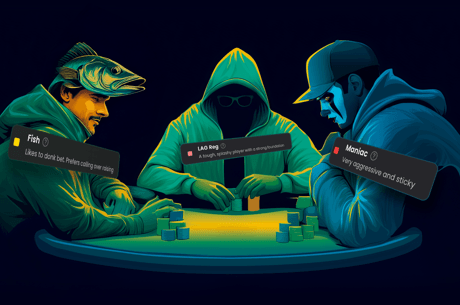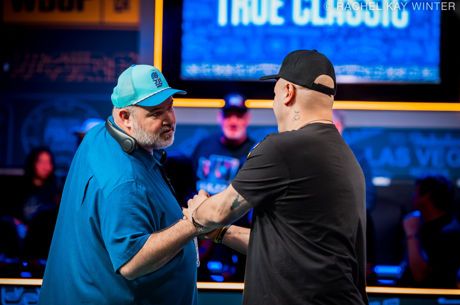"It’s Not a Lie If You Believe It": Learn How to Become a Better Bluffer

There's a good chance you've never heard of Robert Trivers. I hadn't either until recently. But he's an important figure in the field of evolutionary biology, particularly in working out the evolution of social behaviors within and between animal species.
One of his key insights has to do with deception. It had long been recognized that deception is common in virtually all forms of animal communication. Birds will pretend to bury food in one place while actually leaving it someplace else if they know that other birds are watching them. Many species have a form of bluff-charge, to scare off rivals or predators without the danger of an actual fight.
In fact, one kind of male cuttlefish can actually change its coloration pattern so that it looks like a female. He thus gets taken temporarily into the harem of a dominant male that he could not hope to defeat in a battle. Then, when the bigger male is distracted, he changes his color pattern back to its native, and quickly mates with the females.
Trivers's insights about deception — and in particular, self-deception — actually contain a useful lesson about bluffing in poker. Read on.
The Best Bluffers Don't Know They're Bluffing
Trivers deduced that the frequency of deceptive communication in a species would produce strong selective pressure for the ability to detect deception in others. This, in turn, would trigger a kind of evolutionary arms race. Heightened ability to detect deception means that deception has to become more convincing in order to succeed — and when it does, that creates selection pressure to become even better at discernment.
For example, a stick insect survives by looking like part of the branch to a hungry bird. But the birds who are better at seeing through the deception get extra meals and are more likely to survive to reproduce. As the birds get better at picking off the insects, the insects have to evolve ever more sophisticated camouflage to fool their predators.
But, Trivers realized, what's really interesting is that the evolutionary pressure to become better at deception would work best if the animal is self-deceptive — that is, if its deception is done unconsciously, so that there are fewer tell-tale signs of it.
"Self-deception involves the counterintuitive fact that the conscious actor is kept in the dark regarding relevant pieces of information," Trivers wrote in a 1991 book chapter discussing his work. "Our interpretation is that others are cueing in on the actions of the conscious actor, so that keeping it in the dark may be one's first line of defense from others…. Selection for deception may induce self-deception — the better to remain undetected — thus inducing a form of unconsciousness."
This makes perfect sense, not only from the point of view of biology, but as it pertains to poker. Think about it — the most effective bluffers are those who are not aware that they are bluffing.
Consider the novice player who naively believes his middling two pair is the best hand on a board full of possible straights and flushes. The better player with a straight or a baby flush is in a tough spot. He tries to pick up on any sign of weakness, finds none, and mucks. The winner rakes the pot, having no idea that he just induced a fold from a much better hand.
Ignorance Is Bliss
Another example of this circumstance was used as a central plot element in a terrific 1956 poker-themed episode of the Alfred Hitchcock Presents television show called "Crack of Doom."
The story is of a lawyer, Mason Bridges, who gets in over his head in a high-stakes home poker game. In order to recoup his losses, he "borrows" $10,000 that a client had left in his practice's office safe. He has no way to replace it if he loses, so he's desperate. The game is five-card stud, with the first card face down, the other four up, one at a time, each followed by a betting round. They're playing it no-limit.
By the end of the hand, Bridges has three queens showing, and the fourth as his down card, while his opponent has three tens showing, and all indications are that he, too, has quads.
They raise each other until finally Bridges confidently puts his whole ten grand into the middle. This finally convinces his opponent that Bridges really does have four queens, and not just the three he can see. He shows his hidden fourth ten, and reluctantly folds.
Bridges relaxes and takes one last look at his hole card, and discovers, to his horror, that he had misread it — it's actually a jack! Had his opponent called, he would have lost the money, and with it both his career and his freedom.
He admits, as he recounts the story later, that he would never have had the nerve to bet that much on a bluff. His vision had been blurred by so desperately seeing what he wanted to see, and this fact was the only thing that allowed him to project a convincing image of a man sitting on an unbeatable hand.
The Art of Self-Deception
Today's lesson, then, is about bluffing. Of course, it's hard to recommend that you make yourself unaware that you're bluffing. After all, by definition, you can't consciously make an action unconscious. But you can, and should, deliberately think the thoughts you would if you really had the hand that you're representing. Recall George Costanza's much-quoted line from Seinfeld — "it's not a lie if you believe it."
I think most of us do the opposite. While waiting for an opponent to respond to our bluff bet, our thoughts are along the lines of, "Please fold. Oh, please let me get away with it, just this one time! No, don't call! Fold, already, FOLD, DAMN YOU!"
While you're engaged in such thinking, you have to exert considerable effort not to let those toxic thoughts and emotions be translated into visible tells that your opponent might notice. This is difficult, because it means thinking one thing and doing the opposite. The mismatch can leak out as information that betrays you.
You try to laugh to sound relaxed, but it comes across as forced and nervous. You try to sit back as if in confidence, but all your muscles are tensed in a bad imitation of somebody holding a winner. You try to chat nonchalantly, but your voice comes out unnaturally pinched or choppy.
I'm suggesting instead you tell yourself that you actually did catch the winning straight or flush that your opponent is worried about. That is, intentionally induce a mild form of self-deception — specifically, repeating to yourself the thoughts you would have if you really had the winner:
"Yep, I've got it. You're going to be mad when you see that I chased that draw and got there. Please call, dude — I could use the money. There's no better feeling than holding the nuts like this. You're thinking that your top pair is probably good here, but you're wrong. Go ahead and put your chips in, so I can show you just how wrong you are. This pot is mine — all mine."
When you feed yourself a script like this, you don't consciously have to try to imitate the appearance and actions of strength. With a little practice, you can just let them flow naturally from your thoughts, eliminating the dangerous discrepancy between the words running through your panicked mind and your stressed imitation of relaxed body language.
Try this next time the situation calls for running a bluff. I think you'll find that it puts you one step ahead in the arms race of deception and detection that we call poker.
Robert Woolley lives in Asheville, NC. He spent several years in Las Vegas and chronicled his life in poker on the “Poker Grump” blog.
Want to stay atop all the latest in the poker world? If so, make sure to get PokerNews updates on your social media outlets. Follow us on Twitter and find us on both Facebook and Google+!










